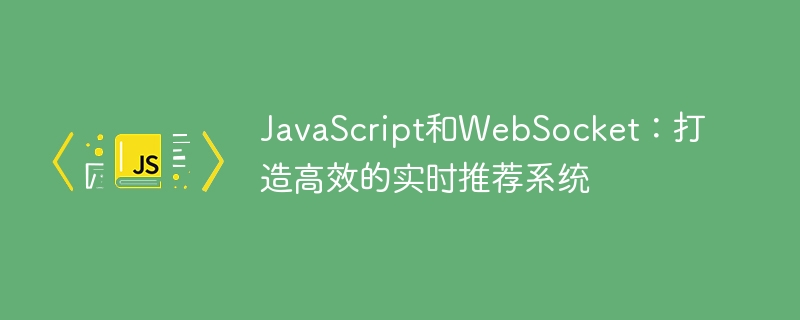Home >Web Front-end >JS Tutorial >JavaScript and WebSocket: Building an efficient real-time recommendation system
JavaScript and WebSocket: Building an efficient real-time recommendation system
- WBOYWBOYWBOYWBOYWBOYWBOYWBOYWBOYWBOYWBOYWBOYWBOYWBOriginal
- 2023-12-18 09:09:401414browse

JavaScript and WebSocket: Create an efficient real-time recommendation system
Overview:
Real-time recommendation system plays an important role in modern Internet applications. It can be based on User preferences and behaviors dynamically provide personalized recommendations. The combination of JavaScript and WebSocket technology provides a powerful tool for building an efficient real-time recommendation system. This article will introduce how to use JavaScript and WebSocket to implement an efficient real-time recommendation system, and provide specific code examples.
WebSocket is a modern communication protocol that provides full-duplex communication capabilities in Web applications and can achieve real-time data transmission. WebSocket has lower latency and higher efficiency than the traditional HTTP protocol, making it ideal for building real-time applications. As a scripting language, JavaScript is widely used in front-end development and has rich features and functions. Therefore, a real-time recommendation system can be easily implemented by combining JavaScript and WebSocket.
Step 1: Establish a WebSocket connection
To use WebSocket to implement a real-time recommendation system, you first need to establish a WebSocket connection. In JavaScript, you can use the WebSocket object to create a WebSocket connection. The following is a sample code:
var socket = new WebSocket('ws://localhost:8080');
// 监听连接成功的事件
socket.onopen = function() {
console.log('WebSocket连接成功');
};
// 监听接收到消息的事件
socket.onmessage = function(event) {
var message = event.data;
console.log('接收到消息:' + message);
};
// 监听连接关闭的事件
socket.onclose = function() {
console.log('WebSocket连接关闭');
};
// 发送消息
function send(message) {
socket.send(message);
}Step 2: Real-time recommendation logic
After establishing the WebSocket connection, the next step is to implement the logic of real-time recommendation. The specific real-time recommendation algorithm and logic vary from application to application, and only a simple example is provided here. Assume that the recommendation system recommends similar articles in real time based on the user's browsing history. The following is a sample code:
// 监听用户浏览记录的事件
document.addEventListener('click', function(event) {
var articleId = event.target.dataset.articleId;
// 发送用户浏览记录
send(JSON.stringify({ action: 'browse', articleId: articleId }));
});
// 处理接收到的推荐结果
socket.onmessage = function(event) {
var message = JSON.parse(event.data);
if (message.action === 'recommend') {
var recommendation = message.data;
console.log('接收到推荐结果:', recommendation);
// 根据推荐结果显示相关文章
displayRecommendation(recommendation);
}
};
// 显示推荐结果的逻辑
function displayRecommendation(recommendation) {
// 将推荐结果显示在页面上
// ...
}Step 3: Back-end implementation of the recommendation algorithm
The previous code only implements the front-end logic, real-time recommendation The system also needs the background to calculate the recommendation algorithm and return the recommendation results. The backend can use any programming language to implement the recommendation algorithm, such as Python, Java or Go. The following is a simple sample code:
import websocket
import json
def on_message(ws, message):
data = json.loads(message)
if data['action'] == 'browse':
articleId = data['articleId']
# 根据用户浏览记录计算推荐结果
recommendation = compute_recommendation(articleId)
# 发送推荐结果
ws.send(json.dumps({ 'action': 'recommend', 'data': recommendation }))
def compute_recommendation(articleId):
# 计算推荐结果的逻辑
# ...
ws = websocket.WebSocketApp('ws://localhost:8080', on_message=on_message)
ws.run_forever()In summary, through the combination of JavaScript and WebSocket, we can easily build an efficient real-time recommendation system. By establishing a WebSocket connection, real-time two-way communication is achieved, and then the recommendation logic is processed separately on the front end and back end, and finally the recommendation results are displayed on the page in real time. This combination of technologies can greatly improve user experience and make recommendation systems more intelligent and efficient.
Of course, the above code is just a simple example, and actual real-time recommendation systems may require more complex recommendation algorithms and logic. But by understanding the use of WebSocket and JavaScript, you can make more specific and complex implementations based on your needs.
Reference materials:
- WebSocket API: https://developer.mozilla.org/zh-CN/docs/Web/API/WebSocket_API
- WebSocket Tutorial : https://www.runoob.com/html/html5-websocket.html
- WebSocket in Python: https://websockets.readthedocs.io/en/latest/intro.html
The above is the detailed content of JavaScript and WebSocket: Building an efficient real-time recommendation system. For more information, please follow other related articles on the PHP Chinese website!

